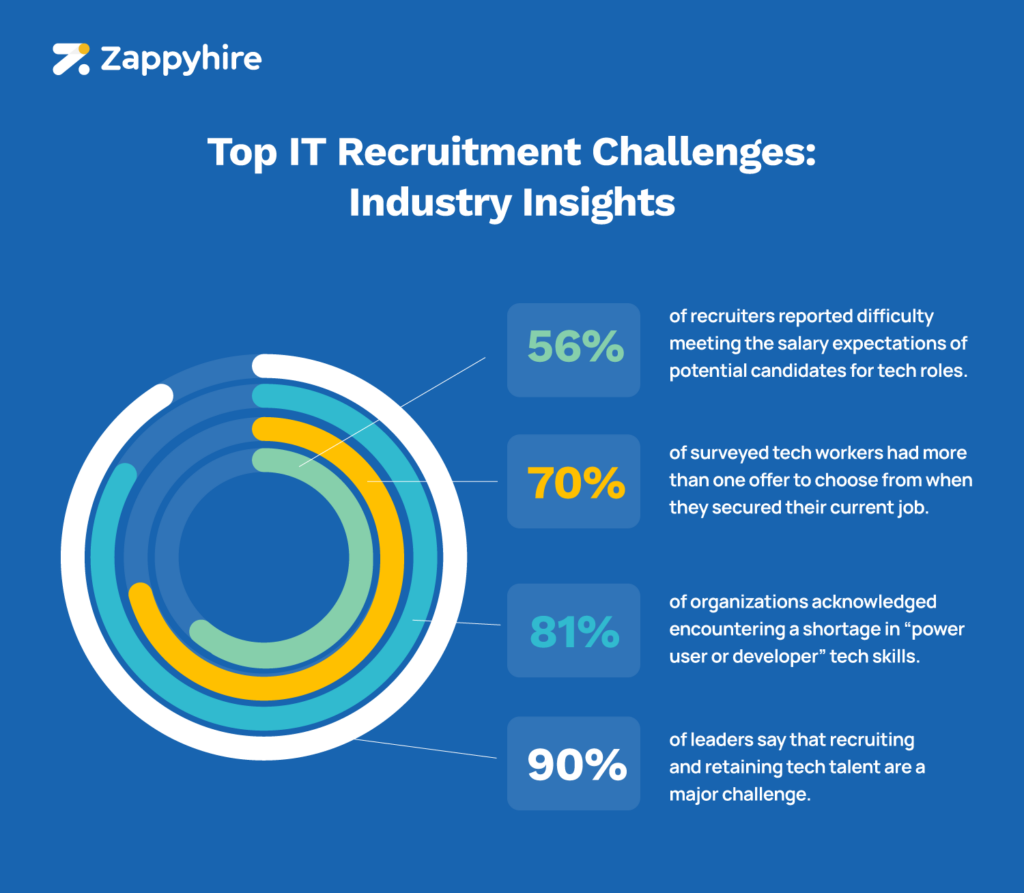
Did you know, it is projected that the information technology (IT) industry is all set to grow at a pace much faster than other industries?
It is predicted that computer occupations in the US will see a 14.2% increase in terms of job opportunities from 2022 to 2032, while all other occupations will grow just by 3%!
This unprecedented growth in the IT sector translates to a significant increase in the demand for skilled tech talent. This comes as a major relief, especially after the surge in layoffs in 2023!
But recruiters, answer us this – how prepared are you to meet this demand, especially considering the global talent shortage and cutthroat competition to secure the best IT professionals?
We get that it’s not easy. The inability to meet the growing demand for highly skilled tech talent is just one among many recruitment challenges faced by tech recruiters.
Top 7 IT recruitment challenges and their solutions

All industries come with their own set of distinct recruitment challenges.
The IT industry is no different as it has certain challenges that recruiters have to face on a daily basis, ranging from the lack of skilled talent to tough competition.
On that note, let’s explore the top 7 IT recruitment challenges and their solutions to ensure that you don’t miss out on the top tech talent you’ve set your eyes on!
Challenge: Talent shortage for high-skill IT roles
Consider this – by the year 2030, it is predicted that there will be a severe global human talent shortage of more than 85 million people.
Alarming to say the least!
In a field as dynamic as the IT industry, which sees rapid and continuous technological advancements daily, the demand for industry-specific specialized talent is on the rise.
Therefore, the advancements that this industry sees outpace the skill development that takes place among the tech talent pool.
This situation where the demand exceeds the supply, has resulted in a significant skills gap in the IT industry. There’s no doubt that this is a serious issue that must be addressed at the earliest.
Solution: Expand the talent pool and upskill the workforce
- Tap into global talent pools with the help of advanced recruitment automation tools. These tools also help you effortlessly adapt to remote work environments!
- Build long-term talent pipelines by implementing internships and apprenticeship programs to get early access to top talent.
- Consider hiring contract or freelance talent for projects that require highly specialized skills, on a contractual and short-term basis.
- Additionally, invest in Learning & Development programs to upskill existing employees on a regular basis.
Challenge: Difficulty in sourcing high-quality talent
Nearly 76% of hiring managers say that attracting the right job candidates is their greatest challenge.
Many organizations miss out on high-quality talent owing to the lack of solid candidate sourcing strategies. This thereby limits their candidate sourcing processes to mainstream channels.
Many qualified candidates that tech recruiters aim to secure are passive candidates, geographically distant, engaged with competitors, etc., making them harder to reach!
It is critical to identify where the top candidates are at to effectively attract them!
Solution: Formulate comprehensive candidate sourcing strategies
- Incorporate passive recruitment strategies into the hiring process (nearly 70% of the global workforce comprises passive talent!).
- Leverage AI-powered recruitment tools to better match skills with job requirements.
- Build relationships with industry communities, forums, and networks.
- Investing in campus recruitment to hire young talent with updated skills and knowledge can go a long way.
- Make use of employee referral programs as it’s proven to be highly effective.
Even though they make up just seven percent of applications, they account for 40% of all successful new hires!
Challenge: Tussle for remote work options
Since the rise of remote work options, candidates across the globe are now actively seeking opportunities that offer such workplace flexibility.
Undeniably, the flexibility to work from home is now a workplace perk and benefit that sets many employers apart from competitors as a top choice.
However, many employers are still skeptical about the outcome of facilitating remote work options at their workplace, with some giving into productivity paranoia!
There is an obvious tussle between employers who are skeptical about issuing return-to-office mandates and employees who greatly value remote/hybrid work options.
This is therefore a major challenge that employers in the IT field especially are faced with owing to the online nature of the jobs in the industry.
Solution: Offer flexible workplace options
- Consider offering remote and hybrid work options (51% of professionals favor a fully remote job, while 46% prefer a hybrid job).
- Organizations must strive to separate themselves from competitors and become employers of choice by offering flexible workplace options.
- In the face of stiff competition it is the perks and benefits that come with such workplace flexibility that give organizations a competitive advantage.
Challenge: Cutthroat competition
The already discouraging talent shortage in the IT sector, coupled with the cutthroat competition among companies makes it very difficult to navigate hiring tech talent.
A survey conducted by Indeed revealed that 70% of those surveyed had more than one offer to choose from when they secured their current job!
This is indicative of the fact that there is significant demand for tech professionals, and this isn’t just limited to the tech industry.
Organizations that belong to different industries as well, actively seek highly skilled professionals,. This could be attributed to the rapid technological advancements across different sectors.
Therefore, companies need to take active measures to ensure they don’t fall behind their competitors when it comes to securing skilled professionals.
Solution: Prioritize candidate needs and boost employer brand
- Offer higher compensation packages, including competitive benefits, perks, and flexible work options.
- Boost the organization’s employer branding and offer an attractive Employee Value Proposition (EVP), to attract the right candidates.
- Improve the candidate experience during the hiring process to snag the top tech talent before other companies.
- Highlight growth opportunities and career development programs. It’s a given that candidates do not like being in the dark about the growth opportunities that come with the job offer.
Challenge: Difficulty in implementing DEI initiatives
Many organizations cite the successful implementation of Diversity, Equity and Inclusion (DEI) strategies as a major challenge.
From reasons such as the lack of effective diversity hiring strategies to the prevalence of hiring bias, organizations admit to falling short in this department.
But the outcome of failing to implement these DEI initiatives is graver than we think.
Nearly 32% of professionals consider it very important to work in a diverse environment, with colleagues of different races, ethnicities, ages, and genders.
So not having a diverse workforce directly impacts the organization’s ability to attract and retain top quality IT professionals, who may choose a competitor who is successful in the same.
Solution: Build effective and tailored diversity hiring strategies
- Identify the root cause of the issue and develop and execute the necessary diversity hiring strategies accordingly.
Examples of such strategies include creating inclusive job descriptions, implementing structured interviews, and using blind resume screening methods, among others. - Train hiring managers and teams on how to conduct fair and just assessments in order to reduce unconscious bias.
- Use automated video interviews to prevent hiring bias by minimizing human involvement.
Challenge: Lengthy hiring processes
A lengthy hiring process is yet another recruitment challenge that hiring teams in the IT field face. This is considered a significant cause for missing out on skilled talent.
Consider this – it takes an average of just ten days for top talent to go off the market!
Therefore, any sort of delay in the recruitment cycle can cost the organization highly qualified professionals.
Either competitors get to them first, or a poor candidate experience forces them to consider organizations with a quick and efficient hiring process!
Either way a golden opportunity is lost.
Hence, it is imperative that organizations take the right measures to ensure they have a quick, streamlined, and efficient recruitment process.
Solution: Adopt recruitment automation tools and effective recruitment strategies to streamline the hiring process
- Recruitment automation platforms automate the time-consuming, manual, and repetitive tasks, saving recruiters a ton of time for other important tasks.
- They also help with faster and more accurate decision making through the insights offered and boosts hiring collaboration.
- Formulate clear and efficient recruitment strategies to eliminate any bottlenecks in the process.
- Training the hiring team on important matters such as time management and process efficiency can also do wonders.
Challenge: High IT recruiting costs
A study revealed that around 56% of employers reported difficulty meeting the salary expectations of potential candidates in the IT industry.
This doesn’t come as a surprise since the median annual wage for IT professionals in the US is almost 2X the median annual wage for all other jobs!
Imagine pairing this with the normally high costs of recruitment, think sourcing, screening, and onboarding to training! It’s enough to burn a hole in a recruiter’s pockets!
Therefore, recruitment in the IT sector is not cheap, it’s not easy, and recruiters are most certainly feeling the strain!
Solution: Strategically plan recruitment budgets and offer perks and benefits
- Carefully plan out the recruitment budgets strategically and cut costs wherever possible.
- Invest in recruitment automation platforms to speed up hiring and improve overall recruitment efficiency, which thereby helps in reducing costs.
- Offer non-monetary incentives and perks and benefits to employees to compensate for the lack of monetary satisfaction.
For example – extra paid time off, wellness programs, recognition programs, etc.
The bottom line…

As we’ve explored in this blog, hiring highly skilled IT professionals is no easy feat, and recruiters have their hands full navigating its choppy waters.
These challenges can be easily overcome if recruiters equip themselves with the right tools and strategies! These include – prioritizing candidate experience, leveraging automation, and boosting employer branding, among others.
Ultimately, the goal is to attract top talent effectively and efficiently and stay ahead of competition in the ever-evolving tech landscape.
If you haven’t explored Zappyhire’s highly advanced recruitment automation solutions yet, you should!
Book a demo today!





